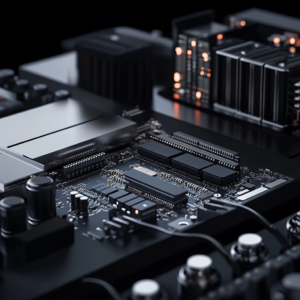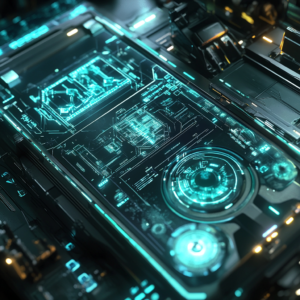1. Introduction
Welcome to my comprehensive exploration of Cutting-Edge Innovations: The Future of Personal Computing. In this article, I share my personal insights and detailed research on breakthrough technologies that are reshaping the personal computing landscape. As digital demands increase, staying ahead by understanding Cutting-Edge Innovations: The Future is essential for tech enthusiasts, professionals, and everyday users alike. This guide will cover the evolution of personal computing, next‑generation hardware, and emerging trends that promise to revolutionize our digital experiences.

Today’s personal computing devices are evolving beyond traditional desktops and laptops. New advancements in processing power, integrated AI, and modular designs are creating systems that are faster, more adaptable, and highly efficient. Let’s dive into Cutting-Edge Innovations: The Future of personal computing and discover the trends that will define technology in 2025 and beyond.
2. The Evolution of Personal Computing
The journey of personal computing has been marked by relentless innovation. From early bulky machines to today’s sleek devices, the evolution is a testament to human ingenuity and technological progress.
Historical Perspective
In the 1970s and 1980s, personal computers were large, expensive, and accessible to only a few. Iconic devices like the Apple II and IBM PC pioneered the personal computing revolution. These early systems laid the groundwork for modern devices, influencing design, user interfaces, and functionality. Today, every component is the result of decades of innovation, and understanding Cutting-Edge Innovations: The Future means appreciating how far we’ve come.
Modern Advancements
Modern personal computing devices prioritize not only raw power but also efficiency, portability, and sustainability. Today’s systems integrate high‑performance components with intuitive software, enabling seamless user experiences. As we look ahead, Cutting-Edge Innovations: The Future continues to drive improvements that make computing more accessible and transformative.
3. Next-Generation Processors and AI Integration
At the core of every personal computing device is the processor. The future of personal computing is being shaped by next‑generation CPUs that offer unparalleled speed, efficiency, and AI integration.
Next‑Generation Architectures
Recent breakthroughs in semiconductor technology have led to processors built on advanced nodes like 5nm and 3nm. These CPUs feature heterogeneous cores designed for specific tasks, dramatically improving multitasking and overall performance. This leap forward is a critical aspect of Cutting-Edge Innovations: The Future of personal computing.
AI Accelerators Embedded in CPUs
Modern processors are now equipped with dedicated AI accelerators. These units allow real‑time processing of machine learning tasks directly on the CPU, enhancing capabilities in areas such as image recognition, natural language processing, and predictive analytics. Such integration exemplifies Cutting-Edge Innovations: The Future by merging traditional computing with intelligent technology.
Real‑World Applications
The practical impact of next‑generation processors is evident across diverse industries. Professionals in fields such as video editing, data analytics, and gaming are witnessing dramatic improvements in speed and efficiency thanks to these advanced CPUs. Additionally, innovations in AI and machine learning are enabling real‑time processing capabilities that transform user experiences. To learn more about how these cutting‑edge processors are applied in real‑world scenarios, please visit AnandTech’s Processors Tag, which offers detailed analyses and case studies on the latest developments in CPU technology.
4. Revolutionary Graphics and Display Technologies
Graphics processing is crucial for immersive experiences and high‑performance computing. The future holds revolutionary changes in GPU and display technologies that are transforming visual computing.
Advanced GPU Architectures
The latest GPUs, developed by companies such as NVIDIA and AMD, feature more cores, higher clock speeds, and innovative memory configurations. These developments result in stunning visuals and superior performance that elevate gaming, video editing, and virtual reality experiences. This progress is central to Cutting-Edge Innovations: The Future of personal computing.
Real‑Time Ray Tracing and AI Enhancement
Modern GPUs now support real‑time ray tracing, which delivers realistic lighting, shadows, and reflections. Combined with AI‑driven image enhancement, these features produce unparalleled visual quality. For further details on GPU performance, please visit Tom’s Hardware GPU Reviews.
Next‑Generation Displays
Display technology is also undergoing a revolution with OLED, mini‑LED, and micro‑LED panels. These displays offer higher resolutions, better color accuracy, and improved energy efficiency. Together, the advancements in GPUs and displays form a major pillar of Cutting-Edge Innovations: The Future of personal computing.
5. Advanced Memory and Storage Solutions
Memory and storage are integral to system performance, and future advancements are set to dramatically improve speed and capacity.
Next‑Generation RAM
The advent of DDR5 memory has brought faster speeds, higher capacities, and lower latency, which significantly enhances multitasking and overall system responsiveness. These improvements are a key element of Cutting-Edge Innovations: The Future of personal computing.
Evolution of Storage Technologies
Solid‑state drives (SSDs) using NVMe technology offer rapid data access and quick boot times, far surpassing traditional hard drives. Emerging technologies such as 3D XPoint and advanced NAND flash promise even greater speeds and durability, ensuring that data-intensive applications run smoothly.
Synergy and Integration
The seamless integration of advanced memory with high‑speed storage solutions leads to improved system performance and user experience. This synergy is essential to Cutting-Edge Innovations: The Future as it allows for efficient data processing and storage management.

6. The Rise of Modular and Scalable Systems
Personal computing is moving toward systems that are more customizable and upgradeable. Modular designs allow users to easily update or replace components, ensuring that devices remain relevant for longer periods.
Modular System Architecture
Modular systems enable users to swap out individual components such as GPUs, memory, and storage without replacing the entire system. This approach not only extends the lifespan of your device but also reduces electronic waste, aligning with sustainable practices. Embracing modularity is a significant aspect of Cutting-Edge Innovations: The Future of personal computing.
Scalability for Evolving Needs
Scalable systems are designed to grow with your requirements. Whether you need more processing power for gaming or increased memory for professional applications, these systems can be upgraded incrementally. This flexibility ensures that your computing setup can evolve alongside technological advancements.
User-Centric Customization
Modular designs empower users to build systems tailored to their specific needs. From selecting high‑performance components to choosing ergonomic designs, personalization is at the core of Cutting-Edge Innovations: The Future of personal computing.
7. Enhanced Connectivity and Cloud Integration
Connectivity is critical in today’s digital ecosystem. The future of personal computing is defined by devices that offer seamless integration with cloud services and advanced networking capabilities.
Faster and More Reliable Networks
Emerging networking standards such as Wi‑Fi 6E and 5G are set to provide faster, more reliable internet connections. These improvements are essential for activities like streaming, online gaming, and remote work, making them a cornerstone of Cutting-Edge Innovations: The Future of personal computing.
Cloud Integration and Data Synchronization
Modern devices are increasingly integrated with cloud services that facilitate data backup, synchronization, and collaboration. This integration not only enhances productivity but also ensures that your data is accessible from anywhere. For more on connectivity, visit CNET’s Connectivity Reviews.
Peripheral and IoT Connectivity
Advanced connectivity options, including Bluetooth 5.2, USB4, and Thunderbolt 4, enable seamless communication between devices and peripherals. These standards ensure that your computing ecosystem is interconnected and efficient, further driving Cutting-Edge Innovations: The Future of personal computing.
8. Security, Privacy, and Data Protection
As personal computing devices become more advanced, ensuring security and privacy remains paramount. Robust security measures are integral to protecting sensitive data and maintaining user trust.
Device-Level Security
Modern devices now incorporate advanced security features such as biometric authentication, hardware encryption, and secure boot processes. These measures help safeguard your system against unauthorized access and data breaches.
Software and Network Security
Keeping your operating system, applications, and network infrastructure updated with the latest security patches is essential. Utilizing firewalls, VPNs, and anti‑malware software further enhances protection. Adopting these practices is crucial for ensuring that Cutting-Edge Innovations: The Future of personal computing remains secure.
Data Backup and Recovery
Regular data backups, whether through cloud services or external storage, are critical in preventing data loss in the event of hardware failure or cyberattacks. Implementing a comprehensive backup strategy is a key component of maintaining digital security.
9. Ergonomics and Sustainable Design
Ergonomics and sustainability are increasingly important in personal computing. A well‑designed system not only enhances productivity but also supports user health and environmental responsibility.
Ergonomic Considerations
Designing an ergonomic workspace involves choosing devices that reduce physical strain. Features such as adjustable stands, ergonomic keyboards, and anti‑glare monitors contribute to a comfortable and healthy computing experience. These aspects are essential to Cutting-Edge Innovations: The Future of personal computing as they ensure long‑term usability.
Sustainable Materials and Practices
Sustainable design involves using eco‑friendly materials and production methods. Manufacturers are increasingly focusing on creating devices that are energy‑efficient and recyclable. This commitment to sustainability is a driving force behind Cutting-Edge Innovations: The Future of personal computing, benefiting both users and the environment.
Aesthetic and Functional Design
A sleek, modern design that is both visually appealing and functional is a hallmark of next‑generation devices. Personal computing products are now designed to complement various workspaces, ensuring that technology integrates seamlessly into your daily life.
10. Future Trends and Emerging Technologies
The future of personal computing promises to be dynamic and transformative. Emerging technologies will continue to push the boundaries of what is possible, reshaping our digital experiences.
AI and Machine Learning Advancements
Future devices will integrate even more sophisticated AI and machine learning capabilities to deliver personalized, adaptive experiences. Intelligent systems will predict user needs, optimize performance, and enhance overall efficiency, representing a major component of Cutting-Edge Innovations: The Future of personal computing.
Immersive Technologies
Virtual reality (VR) and augmented reality (AR) are poised to become integral parts of personal computing, offering immersive experiences that transform entertainment, education, and professional applications. These technologies will blur the line between the digital and physical worlds, opening new avenues for innovation.
Quantum Computing and Beyond
While still in its infancy, quantum computing holds promise for revolutionizing data processing and problem‑solving capabilities. As research progresses, quantum principles may begin to influence personal computing, driving breakthroughs that redefine performance limits.
Next‑Generation User Interfaces
Advancements in user interface design, including voice recognition, gesture control, and holographic displays, will create more intuitive and immersive experiences. These interfaces will make personal computing more accessible and engaging for all users.
Environmental and Social Impact
Future trends will also focus on minimizing the environmental footprint of technology. From energy‑efficient designs to sustainable manufacturing practices, the next wave of innovations will ensure that personal computing is both powerful and responsible.
For more insights on emerging trends, please visit TechCrunch for the latest news and analyses on personal computing innovations.

11. Internal and External Resources
Throughout this article, I have integrated insights from various related topics on VikingBytes.com. For further reading on technological innovations and detailed reviews, please explore our articles on How AI is Revolutionizing Tech: Trends and Innovations and AI in Everyday Life: Practical Applications You Need to Know. Additionally, external sources such as CNET Tech, Tom’s Hardware, and Wired offer comprehensive reviews and expert opinions on the latest computing devices. I also recommend watching the YouTube video “Cutting-Edge Innovations: The Future of Personal Computing” for a visual guide that complements this article.
12. Frequently Asked Questions (FAQ)
Q1: What are the main drivers behind the evolution of personal computing?
A: Key drivers include advancements in processor and GPU technologies, improved memory and storage solutions, and the integration of AI and machine learning for enhanced performance and efficiency.
Q2: How does the move to smaller fabrication nodes affect computer hardware?
A: Smaller fabrication nodes, such as 5nm and 3nm, increase transistor density, which improves energy efficiency, reduces heat production, and boosts overall performance.
Q3: What role does AI play in personal computing?
A: AI is integrated into processors and GPUs to optimize performance, provide real‑time analytics, and enable intelligent system adjustments, leading to a more responsive and efficient computing experience.
Q4: How are sustainable practices influencing the design of new hardware?
A: Manufacturers are using recycled materials, energy‑efficient components, and eco‑friendly production methods to reduce the environmental impact while maintaining high performance and durability.
Q5: What connectivity improvements are expected in future devices?
A: Future devices will benefit from faster interfaces like PCIe 5.0, enhanced USB and Thunderbolt standards, and advanced wireless technologies that enable seamless integration and faster data transfer.
13. Conclusion
Summary of Key Points
In conclusion, the future of personal computing is being shaped by groundbreaking innovations that promise smarter, faster, and more efficient devices. This guide has explored key advancements in processors, graphics, memory, and connectivity, as well as the growing role of AI, sustainability, and modular design. Understanding these trends—Cutting-Edge Innovations: The Future of personal computing—empowers you to make informed decisions and invest in technology that will stand the test of time.
Final Thoughts
As we move further into 2025, the evolution of personal computing will continue to accelerate, driven by both technological advancements and a focus on sustainability. Whether you’re a tech enthusiast, professional, or casual user, staying informed about these innovations will ensure you remain at the forefront of technology. Thank you for reading this comprehensive guide on Cutting-Edge Innovations: The Future of Personal Computing.14. Calls to Action and Affiliate Recommendations
I would like to recommend a tool that has helped me a lot in creating my content, easily creating realistic digital models of people from simple descriptions and exploring the potential of artificial intelligence in digital art. Check it out here.
